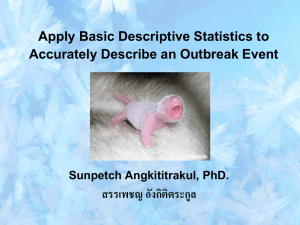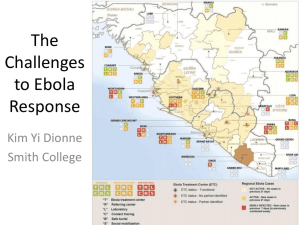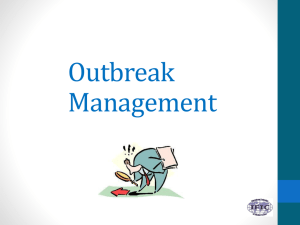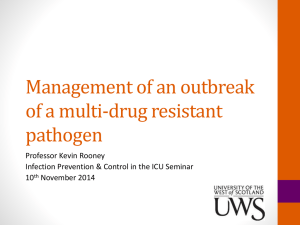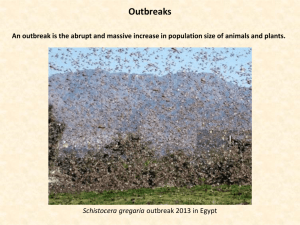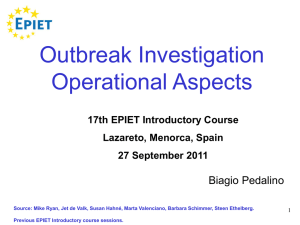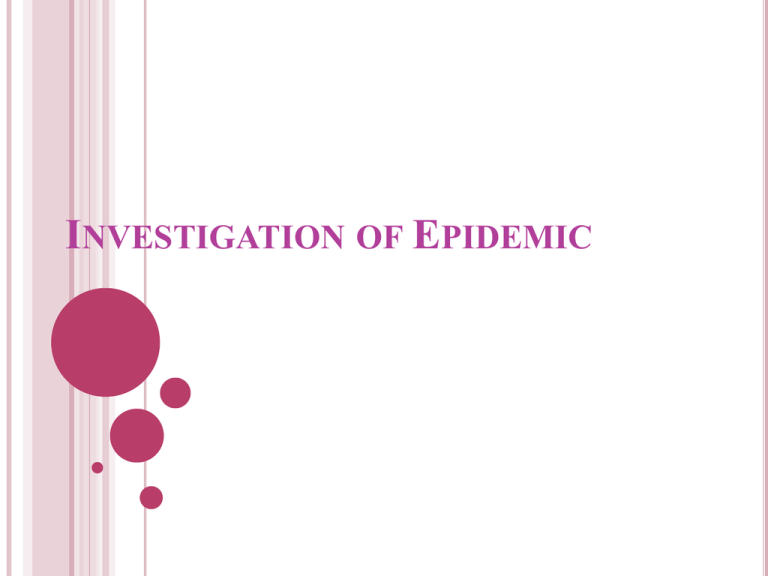
INVESTIGATION OF EPIDEMIC
FRAMEWORK:
Introduction
Definitions
Objectives
Components
of outbreak investigation
Information of outbreak
Steps of an outbreak investigation
INTRODUCTION
Outbreaks can occur anywhere, from a very remote area where
no health facility exists to nosocomial outbreaks in a very
sophisticated hospitals
Many communicable diseases are endemic in India. .
Many of these diseases have seasonal and cyclic trends which
can be discerned through the surveillance system. These
diseases can also cause outbreaks with the potential to spread
rapidly and cause many deaths.
While outbreaks cannot always be predicted or prevented,
recognition of early warning signals, timely investigations and
application of specific control measures can limit the spread of
the outbreak and prevent deaths.
An effective surveillance system is essential for planning,
implementation and monitoring of the diseases.
DEFINITIONS:
Outbreak: It defines when diseases or health events occur at a
greater frequency than normally expected in specified place
and person
e.g:outbreak of HIV i.e. When there is a sharp increase in the
number of HIV cases among sex workers in a city where the
rate was low in the previous year.
Epidemic: It defines when diseases or health events occur in a
very wide geographical area and involves large
population(>5%cases).
e.g When there is high prevalence of HIV is found among the
commercial sex workers in many cities of the country it is
known as epidemic of HIV
Cluster: A group of cases in a certain place over a particular
period without regard to whether the number of cases is more
than expected.
WHY TO INVESTIGATE POSSIBLE
OUTBREAKS?
1.Control & preventive measures
To assess the extent of the outbreak and the size and
characteristics of the population at risk.
To identify factors which contributed to the outbreak
In Mexico, Esinophila-myalgia syndrome was identified
because of ingestion of L-tryptophan
In Gaul sector, an unusual case of fever were reported at RH,
Bhidi in April 2006 for which certain measures were taken
(larval survey, checking of water distribution system, dry day,
chlorination, rally, handouts & pamphlets)
3.Training:
• Investigating an outbreak requires a combination of
-diplomacy,
- logical thinking,
-problem solving ability, -quantitative skills,
- epidemiological know
-how and judgement.
WHY TO INVESTIGATE POSSIBLE
OUTBREAKS? (CONT.)
2.Research opportunities:
For a newly recognized disease, field investigation
provides an opportunity to define the natural
history—including agent, mode of transmission,
incubation period and the clinical spectrum of the
disease.
With this investigators can identify the high risk
population and specific risk factors for the new
diseases toxic shock syndrome in 1980 ,AIDS in
1980’s.
e.g An outbreak of measles in highly immunized
community provides a setting for the investigators to
study vaccine efficacy, the effect of vaccination, and
the duration of vaccine induced protection
WHY TO INVESTIGATE POSSIBLE
OUTBREAKS? (CONT.)
4. Public, political, or legal concerns:
Public has taken interest in disease clusters and potential
environment exposures and they call health departments to
investigate.
Many health departments are showing interest to responsibly
responsive to public concerns even if the concern has little
scientific basis.. Some investigations are conducted because
the laws requires an agency to do so.
5. Program considerations:
o Helps to evaluate the program’s effectiveness (weakness,
opportunity to change or strengthen, scope to improve)
o May identify populations which have been overlooked,
failures in the intervention strategy, changes in the agent, or
events beyond the scope of the program.
INFORMATION OF OUTBREAK:
Health Personnels
Nurses and doctors working in any hospital can report the
unexpected number of cases of any particular disease
Laboratory:
Every laboratory /network can serve as an excellent source
of outbreak investigation e.g in case of Avian influenza
Official disease notification system/or surveillance system
Newspaper or media
Village health volunteers
Calls from a Citizen
e.g A member of the public may report 3 infants born with
birth defects within a 1-month period in the same community
INVESTIGATIVE TEAM INCLUDES
Investigator
Field epidemiologist
Disease control people e.g sanitary inspector, ANM
Laboratory technicians
Specialist in particular areas e.g veterinarian would be very helpful in
outbreak of zoonotic disease
Public health administration for providing logistic support, mobilizing
resources and providing administrative support.
Public relation person :In certain conditions when the outbreak has caused
panic or gained the intense attention of public, the investigative team should
recruit or appoint a person to be in charge of public relations and press
releases. This person should appropriately reassure and not unduly alarm
the public
STEPS OF OUTBREAK INVESTIGATION:
1. Confirm the existence of an outbreak
2. Verify the diagnosis and determine the etiology of the disease.
3. Develop case definition, start case finding, and collect
information on the cases
4. Describe person, place and time and generate hypotheses.
5. Test hypotheses using analytical study
6. Do necessary environmental or other studies to supplement
the epidemiological study
7. Draw conclusions to explain the causes or determinants of
outbreak based on clinical, laboratory, epidemiological &
environmental evidence
8. Report and recommend appropriate control measures to
concerned authorities at the local/national, and if appropriate
at international levels
9. Communication of the findings
10. Follow up of the recommendation to assure implementation
of control measures
CONFIRM THE EXISTENCE OF AN OUTBREAK:
To decide whether the observed number of cases
exceeds the expected numbers we need to first
determine the expected number of cases i.e whether a
cluster is indeed an outbreak
Data can be collected from
health department surveillance records can be used.
locally data can be collected from
hospital discharge records, mortality statistics, cancer or
birth defect registries
Community survey
Before launching a full investigation, verify signs, symptoms &
test results
Compare the current number of cases with the number from the
previous few weeks or months or from a comparable period
during the previous few years
VERIFY THE DIAGNOSIS AND DETERMINE THE
ETIOLOGY
Verification of diagnosis
clinical findings
laboratory results
Investigator should visit several patients with the disease. In
case if a sound clinical background is not known than a
qualified physician can be taken for the investigation.
Certain questions can be asked to the patients to reach to a
diagnosis
What were their exposures before becoming ill?
What do they think caused their illness?
Do they know anyone else with the disease?
Do they have anything in common with others who have the disease?
DEVELOP CASE DEFINITION, START CASE FINDING,
AND COLLECT INFORMATION ON CASES
Confirmed cases– have a positive laboratory result (isolation
of the causative agent or positive serological test).
e.g outbreak of bloody diarrhoea E.coli 0157:H7 is isolated
from a stool culture
Probable cases – have the typical clinical features of the
illness but without laboratory confirmation.
e.g bloody diarrhoea or hemolytic uremia syndrome without
microbiological confirmation
Possible case: have fewer or atypical clinical features.
e.g. non-bloody diarrhoea without microbiological
confirmation
STEPS:
Active surveillance
-peripheral health personnel,
- personnel from other government departments,
-NGOs and key community representatives
Valuable information can be obtained by contacting key
community representatives, especially if the outbreak is focal.
Passive surveillance
COLLECT THE FOLLOWING TYPE OF INFORMATION ABOUT
EVERY CASE
Identifying
information:
name, address, and telephone number
Demographic information:
age, sex, race, and occupation
Clinical information:
Risk factor information:
Investigation of hepatitis A ,information regarding
exposure to food and water
Reporter information:
Line listing: Collected information is described on a
standard case report form known as line listing.
In a line listing each column represents an important
variable such as name or identification number ,age ,sex
,case classification etc. while each row represents a
different case .New cases are added to a line listing as they
are identified
DESCRIBE PERSON, PLACE AND TIME AND GENERATE
HYPOTHESES.
Distribution by time:
The
onset of illness of the cases should is
graphed(histogram) by hours, days, weeks or months. This
graph is known as epidemic curve
Epidemic curve:
confirming the existence of an epidemic
forecasting of the further evolution of the epidemic
identifying the mode of transmission
determining the possible period of exposure and/or the
incubation period of the disease under investigation
identifying outliers in terms of onset of illness, which might
provide important clues as to the source.
Two types of outbreaks
1. Common source
2. Propagated source
1.Common source outbreak: This outbreak occurs when people
gets the infection by exposure to the same source of infection.
These are two types
Point common source: When there is single source that
exists for the short time and all cases have common exposure to it
in that same particular period.
Continuous common source: The epidemic curve
shows an abrupt increase in number of cases but
instead of having a peak decline within incubation
period new cases persist for a longer time with a
plateau shape instead of peak before decreasing.
If there are many peaks or irregular jagged curves this
suggest an intermittent common source
Propagated source: This type of outbreak is caused by a
transmission from
one person to another person which requires
direct contact such as touching,
bitting, sexual contact
Slow increase in number of cases with progressive peaks
approximately one
incubation period apart. The span of 1st and
last case will also last longer than several incubation period e.g
HIV
DISTRIBUTION BY PERSON
Index case: The first case on epidemic curve is index case. It is
important with the possibility that he/she brought the infection to
the community.
Outlier case: The case which appears at the beginning and at the
end of the curve are known as outlier case. They provide
information about the source and the way disease is spreading in
that territory.
DISTRIBUTION BY PLACE
The investigator can calculate the attack rate of case by different
place .This can be place of residence ,place of work and place of
exposure and soon plot a spot map showing the source of
infection or contamination
If cases are scattered in many place, investigator should explore
the secular pattern of the case over time. This will indicate about
the spread of outbreak from one area to another area or whether
people living in different place had a common exposure
GENERATION OF HYPOTHESIS :
Hypothesis can be generated by 2ways
1)First- Consider what you know about the disease itself?
-What is the agent’s usual reservoir?
-It’s transmission
-What vehicles are commonly implicated?
-What are the know risk factors?
2)Second- talk to few case patients by visiting to their
homes to search for common exposures.
-Local staff community will provide information
Descriptive epidemiology provides some information
If the epidemic curve points to a narrow period of exposure
What events occurred around that time?
Why do the people living in a particular area have the highest
attack rates?
Why are some groups with particular age, sex & other person
characteristics, at greatest risk than other group with different
person characteristics
TEST HYPOTHESES USING ANALYTICAL
STUDIES
Hypothesis can be tested by comparing the hypothesis
with the established facts or by using analytical
epidemiology to quantify relationship &explore the role
of chance.
Analytical studies like-cohort &case-control studies.
Do necessary environmental or other studies to
supplement the epidemiological study:
Although an analytical study might be able to confirm the
hypothesis ,the investigator still needs to find
environment or other evidence to support and explain the
epidemiological evidence
DRAW CONCLUSIONS TO EXPLAIN THE CAUSES OR
DETERMINANTS OF OUTBREAK BASED ON CLINICAL,
LABORATORY, EPIDEMIOLOGICAL& ENVIRONMENTAL
EVIDENCE
The investigator must identify the cause of outbreak based on
the agreement of following piece of evidence
Laboratory
Clinical
Environmental
Epidemiological
The epidemiological evidence found by the descriptive and
analytical study should explain
Pattern of spread as described by epidemic curve
Statistical strength of association between exposure an
developing the disease.The dose response relationship
which demonstrates high strength by association when
exposure is increased
Exposure should precede illness
REPORT AND RECOMMEND APPROPRIATE
CONTROL
MEASURES TO CONCERNED AUTHORITIES AT THE
LOCAL/NATIONAL, AND IF APPROPRIATE AT
INTERNATIONAL LEVELS:
The investigator should timely report the findings to the
responsible individuals at local, national and
international levels, so that appropriate action should be
taken
Two task should be completed before leaving the field
1) Complete analysis and data interpretation
2) Present main finding with recommendation

